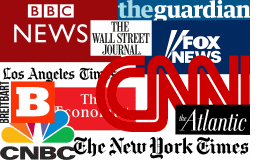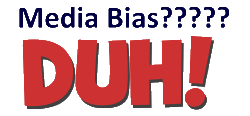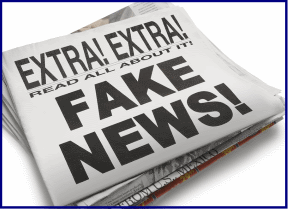
 News Media Bias
News Media Bias
Sooo...maybe you've noticed.
More and more
folks these days
want us to see that news media,
especially so-called
"mainstream" news, is biased.
Frankly, we wonder why they are bringing
up something that has been known FOR A LONG TIME! Besides,
as we point out elsewhere, some measure of bias is inevitable
everywhere, including this website.
So we started looking into it further, and we
found a few things:
1. While folks correctly see there is bias
in news media, they often don't know the main reason for it,
2. They don't fully know the nature of news media, media bias,
and
3. They appear not to know that bias
is inevitable (as we've discussed elsewhere), so our task is to
recognize, not
decry it, and then
analyze it via critical thinking and from there compensate for
it.
4. And most important of all, many use
this media bias notion as a way to
delegitimize and
disregard factual information that they don't like that has been
provided by mainstream
news media. In other words, they "Throw out the baby
with the bath water."
They may correctly identify a bias (e.g., this news media
mostly publishes
stories about conservative concerns), and then throw out the
factual information
correctly contained in the news article.
 Time for a little analysis.
Let's start with this...
Time for a little analysis.
Let's start with this...
The media earn money via advertising.
The amount the media can charge and the
amount of advertising the media can attract is based on how many
people will see the advertising.
That's the primary media bias: Providing things
people want to see and/or read.
 Do you remember the old adage:
If it
bleeds, it leads? Whether this was ever actually true, or
not, it points out the notion that folks would be more
attracted to that sort of story. Yes, they reported on more
than that, but more often they did what would get viewers and/or
readers. In 1986 a book by that title written by Laura Di Battists came out.
Do you remember the old adage:
If it
bleeds, it leads? Whether this was ever actually true, or
not, it points out the notion that folks would be more
attracted to that sort of story. Yes, they reported on more
than that, but more often they did what would get viewers and/or
readers. In 1986 a book by that title written by Laura Di Battists came out.
To sum up:
The media is biased toward providing that
which will increase viewers and readers and thereby
increase advertising revenue. That is the primary bias. Nothing more. Nothing
less.
What this means is that the specific media
presented (the true and factual stories they choose to present and how they are
presented) is targeted toward those who want to read and/or see it.
This is where to start when looking at
news media bias.
 Fox
News is seen as a conservative news source, choosing to broadcast news stories that
conservative viewers are more interested in seeing.
Fox
News is seen as a conservative news source, choosing to broadcast news stories that
conservative viewers are more interested in seeing.
 MSNBC
is a liberal news source, one that chooses to broadcast news stories
liberals are interested in seeing.
MSNBC
is a liberal news source, one that chooses to broadcast news stories
liberals are interested in seeing.
News stories: Both of these provide factual news that is biased
toward target viewers.
Opinions: Both can and often do includes analyses and
opinions regarding the factual news presented. As viewers, we are
free to filter out and/or disagree with any analyses, or opinions, but
we best not also discard that valid facts that may be reported. Of
course, we are free to do follow-up to check the source of the facts.
Are there additional biases???
Yes, there are, and an online search will
reveal many of them. Here is a list of a few:
Coverage bias (also known as visibility bias),
deciding
which individuals, events, or issue will be more, or less presented
in the news.
Gatekeeping bias (also known as selectivity or selection bias),
similar to coverage bias,
done on ideological grounds to fit some agenda.
Statement bias (also known as tonality bias or presentation bias),
when media coverage is slanted towards or against
the statements
made by particular individuals or in relation to
particular issues, often ignoring whether the
statements are valid, or not.
This also includes the tone used, often expressed
in adjective (e.g., "Fred confessed that..." vs. "Fred said that...")
Advertising bias, when stories are selected or slanted to please
advertisers.
Concision bias, a tendency to report
views that can be summarized
briefly and
succinctly, crowding out more complicated and sometimes
unconventional views that take time or space
to
explain.
Corporate bias, when stories are selected or slanted to please
corporate owners of media.
Political bias, similar to corporate bias, but slanted to meet
political agendas (see Fox News and MSNBC examples above).
Repetition bias,
a tendency to report what everyone else is reporting,
while avoiding stories that might
offend anyone.
Sensationalism,
like the "if it bleeds it leads" bias,
this bias is often in favor of the exceptional over the
ordinary (e.g. reporting airplane crashing more often than
automobile crashes).
Structural bias, when an
individual, or an issue is given more or
less favorable coverage as a result of status and
newsworthiness, rather than any larger consideration (e.g.,
reporting the views and statements of an incumbent politician rather
than those of anyone outside the current political structure).
False balance, when an issue is presented as even sided, despite
evidence that it is not (e.g.,
reporting false statements that oppose true statements as if both were
true).
Factual News vs. Opinion Pieces
This is a very important distinction to keep in
mind. Opinion pieces may be based upon facts revealed in the news,
but they are just opinions and as such they are biased by the intent of
the writers. Factual news stories may have one, or more of the
biases mentioned above, but op-ed pieces are biased in terms of the
point the writer is trying to make. When assessing the bias of a
news media outlet, it is important to separate the opinion pieces from
the factual news pieces. At the same time, it is important to note
the extent to which an opinion pieces might masquerade as fact (thereby
bordering on fake news).

This brings us to this hot topic:
FAKE NEWS
It goes without saying that fake news is
always biased. It is always presented to present some sort
of false information for some sort of gain, or benefit.
Recent geological studies now prove the earth is flat!
Mathameticians now know that 2 + 2 = 5
There, that's some fake news for you...
Fake news vs. biased news:
First, in our experience, fake news is
most often found online, often from fake news web sites.
Second, it is very important to understand that not
all biased news is fake news, but all fake news is biased.
How to tell them apart? Well, for
one thing, while both can contain false, or
erroneous facts, or information that is biased, news that is
ONLY biased can and will be corrected when it is found to
be wrong.
Fake news is NEVER corrected. Why? Because those who
provide fake news will NEVER acknowledge that it is fake.
So if it is not fake, it must be true, and it never needs to be
corrected, or modified.
Ways to identify online fake news:
Here are some ways to find out whether or
not an online news item is fake.
1. Check the URL of the story to see if it
comes from a legitimate news source. For example, abcnews.com.co
is NOT a legitimate site for ABC news (abcnews.com is the
legitimate site). Also, check to see if the URl actually leads
to anything resembling a valid source of news, not simply
opinion.
2. If someone deemed important (e.g.,
George Washington) is quoted, do a search for the quote using a
search site (e.g., Google). It is important to distinguish
between that which is posted (it might be something of value, or
it might be something that smears of demeans) and the purported
source (often such sources are offered to make the quote seem
more valid and/or important).
3. Reverse search questionable image.
Right click on the image, copy the URL of the image source, then
go to images.google.com, paste the image to see where it came
from. If it is a doctored image, you can often find the original
image.
4. Use websites that can check facts
(e.g., politifact.com and factcheck.org) and check for scams
(e.g. snopes.com). Finally, to check for email and FB hoaxes
(e.g. at truthorfiction.com and Hoaxslayer.com). Note that some
have claimed these sites are biased, and while the various
biases listed above may apply, they don't just check the facts
but they also site sources. So if and when you use them,
you can filter out the biases and verify on your own using the
sources sited.
 News
vs. Opinion: It is important to recognize that news media
often offer platforms for opinions (in newspapers often referred
to at the op-ed page). Opinions often include true facts,
but in the end they are efforts to analyze and/or interpret the
facts and draw conclusions. As a result, it is important
to recognize that they may show any number of the biases cited
above in choosing facts for forming opinions. Also, it
important to recognize opinions are present (sometimes imbedded
in a news story) but not labeled as such.
News
vs. Opinion: It is important to recognize that news media
often offer platforms for opinions (in newspapers often referred
to at the op-ed page). Opinions often include true facts,
but in the end they are efforts to analyze and/or interpret the
facts and draw conclusions. As a result, it is important
to recognize that they may show any number of the biases cited
above in choosing facts for forming opinions. Also, it
important to recognize opinions are present (sometimes imbedded
in a news story) but not labeled as such.

